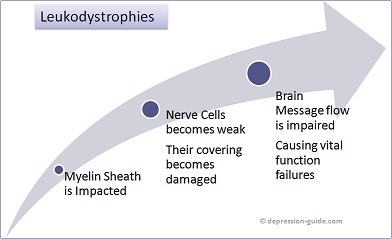Leukodystrophies - Symptoms, Treatment and Causes
TweetLeukodystrophies is a very rare disease. It affects the brain cells and and specifically the myelin sheath which covers the nerve cells and protects them. If the covering of nerve cells is weakened, then message flow between brain and body is slowed which causes issues in walking, speaking, hearning, physical development, etc.
Almost all the leukodystrophies are fatal some in short term while others in medium term. There is no treatment available for leukodystrophies currently. Medicines, speech therapy and other physical therapy can alleviate some symptoms, but it does not cure the illness.
Leukodystrophies is prevalent among young children and adults as well. Its chances of occurance are 1 in 10000 people. In most os the cases there is a severe motor and cognitive skills damage. All of this occurs very rapidly and there is premature death within 2-5 years of disease occurance. It can recurr in the family which has a family history of leukodystrophies.

How leukodystrophies impacts people?
There is a change in the myelin sheath which causes the nerve cells incapable of functioning properly. If the disease affects the part of the brain which processes images - visual images, then it can cause partial to complete blindness although the eyes are perfectly normal. The issue is with the transmitting nerve which becomes incapable to transfer images from one eye to the part of the brian which processes it. Because of this the motor, sensory and intellectual functions are impacted to different degrees of severity.
Types of leukodystrophies
Based on the place where leukodystrophies is impacting the brain, there are multiple forms of leukodystrophies. Some of the them are adrenoleukodystrophy, Krabbe’s disease and metachromatic leukodystrophy. In some of these cases, bone marrow transplant helps and the disease progression can be stopped. While in some other form of leukodystrophies, only symptom control is only available treatment option and the disease just stays and gets worse.


Sometimes crying or laughing
are the only options left,
and laughing feels better right now.

Current Issue
 Self Help Leaflets Take the help of our self help leaflets or booklets. |
 The DG Magazine All about living with depression |
Brain Disorders
Brain Disorders
- Transverse myelitis
- Chiari malformation
- Amyotrophic lateral sclerosis
- Coma
- Concussion
- Encephalitis
- Delirium
- Essential Tremor
- Post Concussion Syndrome
- Brain Tumor
- Intracranial Hematoma
- Transient global amnesia
- Reye's syndrome
- Autonomic neuropathy
- Bell's palsy
- Acoustic neuroma
- Benign paroxysmal positional vertigo (BPPV)
- Brachial plexus injury
- Cerebral palsy
- Charcot Marie Tooth disease
- Complex regional pain syndrome
- Dystonia
- Foot drop
- Guillain-Barre syndrome
- Krabbe disease
- Meniere's disease
- Myasthenia gravis
- Optic neuritis
- Peripheral neuropathy
- Phantom pain
- Post-polio syndrome
- Postherpetic neuralgia
- Progressive supranuclear palsy
- Ramsay Hunt syndrome
- Spasmodic torticollis
- Spinal cord injury
- Spinal stenosis
- Trigeminal neuralgia
- Vocal cord paralysis
- Whiplash
- Primary progressive aphasia
- Leukodystrophies
- Wilson's Disease
- Aneurysm
- Aphasia












